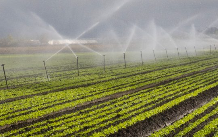Gardeners know the amount of time and energy it takes to grow the tomatoes, cucumbers, and zucchini they share with friends and neighbors. Once the soil is prepared then the seeds need to be sown, the weeds need to be fought, the plants need to be watered, and the insects, diseases, and parasites need to be stopped. That is all before the first slice of tomato can be laid upon a plate.
Now imagine the sort of energy it would take to grow 200 acres of a crop, or 1,000 acres. This is the task before America’s agricultural employers.
Many crops in the United States must be handpicked for them to appear in your local grocery store. Automated machines can’t replicate how a human hand harvests crops such as garlic, strawberries, or asparagus.
Those crops that can use harvesting equipment still need humans to help move them through processing systems before they can enter the food supply. To protect those workers, labor laws were first established in 1938, according to U.S. Department of Labor website at bit.ly/3spIBHY, with the passing of the Fair Labor Standards Act.
The original laws put in place have changed drastically over the years but the need for agricultural labor has not. A recent webinar hosted by The National Agricultural Law Center discussed the labor laws agricultural employers should be familiar with when they need to hire outside help.
Host Brandon Davis is a farmer and a lawyer at the New Orleans office of Phelps Dunbar. He specializes in immigration as it pertains to labor issues facing agricultural businesses.
“We cannot go from farm to table without an adequate labor supply,” Davis said.
Davis said that agricultural jobs cannot always be filled by American citizens even though employers are required to advertise those positions on national job boards at bit.ly/3spGbJo. When no American applicants have been found, the federal government gives the employer the certification that will then need to be approved by immigration.
The act of finding stable agricultural employees is not quick and it is not cheap. Once those employees arrive on U.S. soil there are laws in place to ensure they have fair wages, which could be anywhere between $13 to $17 an hour; housing paid for by the employer that meets local and county standards that defaults to Occupational Safety and Health Administration and Migrant and Seasonal Agricultural Worker Protection Act standards; and training that allows the employees to remain safe and healthy.
Agricultural employees have “the right to be safe. The right to be healthy in their environment. The right to be safe from discrimination,” Davis said.
Safe and sound
Agriculture is one of the most rewarding professions but it is also one of the most hazardous. Safety for employees starts with thorough training on how to navigate the dangerous situations and materials they work with on a daily basis.
One of the biggest threats to agricultural employees is heat and heat-related illnesses. Agricultural employers and their managers must have policies in place and be flexible so employees can take adequate water and rest breaks during the hottest part of the day, which Davis said is between 11:45 a.m. and 3:15 p.m. These breaks are especially important for newly hired employees that need time and patience while they acclimate to the heat.
“The last thing that we want is a work-related illness or death that is absolutely preventable like heat related illnesses,” Davis said. He directed attendees to OSHA’s heat-related illness website at osha.gov/heat for more information.
Many retired farm kids can attest to the effects of prolonged exposure to loud machinery on their ability to hear later on in life. Davis emphasized that agricultural employers must make sure employees know how to protect their hearing with ear plugs or headphones when operating noisy combines, chainsaws, or trenchers, just to name a few pieces of equipment.
Additionally, operating that noisy machinery should be limited to those older than age 16, Davis said. Legally, 16-year-olds can only operate a tractor that has less than 20 horsepower. They are also not supposed to be working in an enclosed area with a stud horse, a bull, or a boar. Many farms are family operations and children are often tasked with work beyond their age and abilities. Davis said 12 years is generally the minimum age for working on the farm.
Mistakes can be made no matter the age of the employee and Davis said that’s where effective training becomes evident.
“Good mistakes are the ones where we’ve had training and we know what to do,” he said.
While some employers may see these laws as a hindrance to their productivity, Davis reminds them that there is not enough Americans who want to do farm labor, so employers must do what they can to protect those who are willing to work for them.
“We don’t have enough labor to produce the food that we need in the country and the food that we sell internationally,” Davis said.
As reported in the High Plains Journal.




